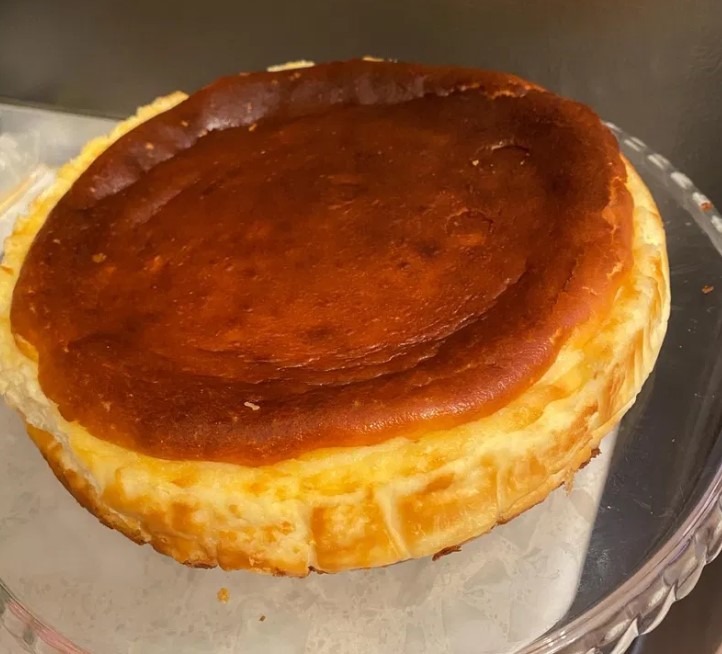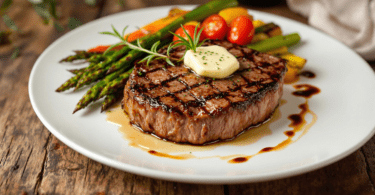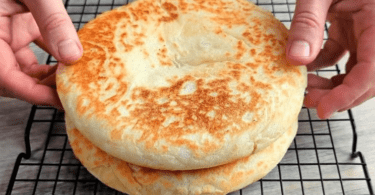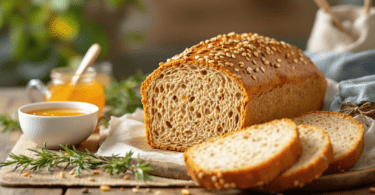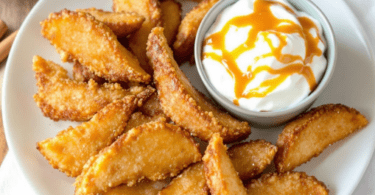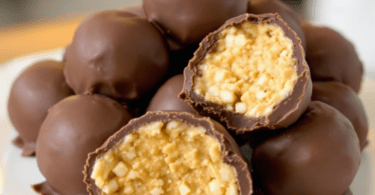Burnt Basque Cheesecake, also known as “La Viña Cheesecake,” hails from the Basque region of Spain, where it was first served at the La Viña restaurant in San Sebastián. This unique cheesecake is known for its burnt, caramelized top and a creamy, custard-like center. Unlike traditional cheesecakes, it doesn’t require a crust, and its rustic appearance—deeply browned, almost charred edges—is part of its charm. Despite its slightly intimidating look, this cheesecake is surprisingly easy to make and irresistibly delicious.
Why You’ll Love This Recipe
- Simplicity: With only a handful of ingredients and minimal preparation, this recipe is straightforward, making it perfect for both beginner and experienced bakers.
- Texture: The contrast between the creamy interior and the slightly burnt exterior creates a perfect balance of flavors and textures.
- Flavor: The caramelized top adds a rich, deep flavor, while the inside remains sweet, tangy, and smooth.
- No Crust Required: Say goodbye to the hassle of making a crust—this cheesecake shines all on its own.
Variations
- Chocolate Basque Cheesecake: Add melted chocolate to the batter for a rich, chocolatey twist.
- Citrus Twist: Add lemon or orange zest to the batter for a refreshing, zesty flavor.
- Vanilla Bean: Mix in vanilla bean seeds for a fragrant and flavorful enhancement.
Storage
- Refrigeration: Store the cheesecake in an airtight container in the refrigerator for up to 3-4 days. The flavors often deepen with time, making it even more delicious after a day or two.
- Freezing: You can freeze the cheesecake by wrapping it tightly in plastic wrap and placing it in an airtight container. It can be frozen for up to 2 months. Thaw in the refrigerator before serving.
Nutritional Info (per serving)
- Calories: Approximately 350-400 kcal
- Fat: 25g
- Carbohydrates: 25g
- Protein: 6g
- Sugars: 20g
- Fiber: 0g
(Note: Nutritional information may vary depending on specific ingredients used.)
FAQ
- Can I use low-fat cream cheese? It’s best to use full-fat cream cheese to achieve the rich, creamy texture that defines a Burnt Basque Cheesecake.
- Why does my cheesecake crack? Cracking can occur if the cheesecake is overbaked. The center should still be slightly jiggly when you take it out of the oven.
- Do I need to use a water bath? No, a water bath is not necessary for this cheesecake. Its rustic appearance allows for some cracking and uneven browning.
Ingredients
- 2 pounds (900g) cream cheese, at room temperature
- 1 1/2 cups (300g) granulated sugar
- 6 large eggs
- 2 cups (480ml) heavy cream
- 1/4 cup (30g) all-purpose flour
- 1/2 teaspoon salt
- 1 teaspoon vanilla extract (optional)
Step-by-Step Directions
- Preheat the Oven: Preheat your oven to 400°F (200°C). Line a 10-inch springform pan with parchment paper, leaving extra paper hanging over the sides.
- Mix Cream Cheese and Sugar: In a large bowl, beat the cream cheese and sugar together until smooth and creamy.
- Add Eggs: Add the eggs, one at a time, beating well after each addition.
- Incorporate Cream and Flour: Add the heavy cream and mix until fully incorporated. Sift in the flour and salt, and mix until smooth. Stir in vanilla extract if using.
- Bake: Pour the batter into the prepared pan. Bake for 50-60 minutes, or until the top is deeply browned and the center is still jiggly.
- Cool: Allow the cheesecake to cool completely in the pan. The cake will deflate as it cools, creating its characteristic burnt top.
- Serve: Carefully remove the cheesecake from the pan and peel away the parchment paper. Slice and serve at room temperature or chilled.
Conclusion
Burnt Basque Cheesecake is a delightful dessert that stands out for its rustic look and decadent taste. Whether you’re an experienced baker or just starting, this recipe is sure to impress. Its rich flavor, creamy texture, and unique appearance make it a crowd-pleaser for any occasion. Enjoy the simplicity of preparation and the complex flavors that this cheesecake offers!
Sources and References
- “Burnt Basque Cheesecake” by NYT Cooking
- “The Story Behind Burnt Basque Cheesecake” by Bon Appétit
- “How to Make Basque Cheesecake” by Serious Eats


 Flip it!
Flip it!
